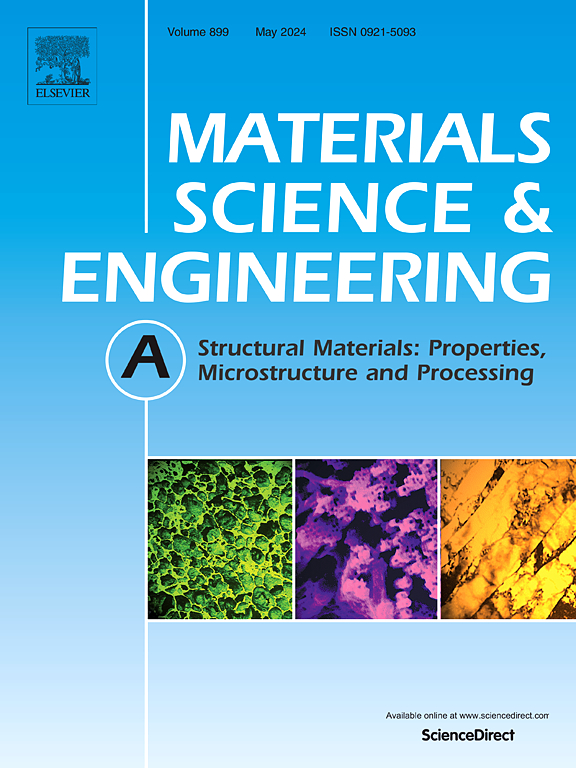Achieving unique interfacial structure, excellent mechanical performance and desired degradation behavior in novel Zn/Mg shell-core biocomposites via a two-step co-extrusion process
IF 7
2区 材料科学
Q1 MATERIALS SCIENCE, MULTIDISCIPLINARY
引用次数: 0
Abstract
Herein, to address the clinical need for biodegradable materials that provide mechanical support through slow degradation in the early stages of implantation and rapid degradation after bone healing to reduce the implant's residence time in the body, a novel Zn/Mg shell-core biocomposite was developed via a precisely controlled two-step co-extrusion process. A unique interface structure, consisting of an MgZn2 intermetallic interlayer, a Mg-rich diffusion layer in the Zn matrix, and a Zn-rich diffusion layer in the Mg matrix, was confirmed in the experimental composites. Through low-temperature and low-speed secondary extrusion, the grains of the Mg core and Zn shell were significantly refined, with average grain sizes of 0.51 μm for the Mg core and 1.45 μm for the Zn shell. Thanks to the intimate interfacial connection and the significant grain refinement, an ultimate tensile strength (UTS) of 337.5 MPa, a yield strength (YS) of 311.4 MPa, and failure strain of 16.3 % were achieved, indicating a good balance of strength and plasticity. After 4 months of immersion in simulated body fluid (SBF), the Zn/Mg bimetallic composite exhibited a degradation rate of 0.016 mm/y, demonstrating that the Zn shell effectively protects the Mg core from corrosion, maintaining mechanical integrity during the initial period. Through precise adjustment of Zn shell thickness, the composite's degradation period can be precisely tuned within a broad range of 5–72 months, enabling optimal matching with bone regeneration timelines. This investigation establishes a novel paradigm for designing biodegradable implants with degradation profiles tailored to physiological healing processes.
通过两步共挤工艺,获得了独特的界面结构、优异的力学性能和理想的降解行为
为了满足临床对生物可降解材料的需求,通过在植入早期的缓慢降解和骨愈合后的快速降解来提供机械支持,以减少植入物在体内的停留时间,我们通过精确控制的两步共挤压工艺开发了一种新型的Zn/Mg壳核生物复合材料。复合材料具有独特的界面结构,由MgZn2金属间层、Zn基体中的富Mg扩散层和Mg基体中的富Zn扩散层组成。通过低温低速二次挤压,Mg芯和Zn壳的晶粒均得到了明显细化,Mg芯和Zn壳的平均晶粒尺寸分别为0.51 μm和1.45 μm。由于紧密的界面连接和显著的晶粒细化,合金的极限抗拉强度(UTS)为337.5 MPa,屈服强度(YS)为311.4 MPa,破坏应变为16.3%,达到了良好的强度与塑性平衡。在模拟体液(SBF)中浸泡4个月后,Zn/Mg双金属复合材料的降解率为0.016 mm/y,这表明Zn外壳有效地保护了Mg核心免受腐蚀,在初始阶段保持了机械完整性。通过对锌壳厚度的精确调节,复合材料的降解周期可以在5-72个月的大范围内精确调节,从而实现与骨再生时间表的最佳匹配。本研究建立了一种新的设计可生物降解植入物的范例,其降解特征适合生理愈合过程。
本文章由计算机程序翻译,如有差异,请以英文原文为准。
求助全文
约1分钟内获得全文
求助全文
来源期刊

Materials Science and Engineering: A
工程技术-材料科学:综合
CiteScore
11.50
自引率
15.60%
发文量
1811
审稿时长
31 days
期刊介绍:
Materials Science and Engineering A provides an international medium for the publication of theoretical and experimental studies related to the load-bearing capacity of materials as influenced by their basic properties, processing history, microstructure and operating environment. Appropriate submissions to Materials Science and Engineering A should include scientific and/or engineering factors which affect the microstructure - strength relationships of materials and report the changes to mechanical behavior.
 求助内容:
求助内容: 应助结果提醒方式:
应助结果提醒方式:


